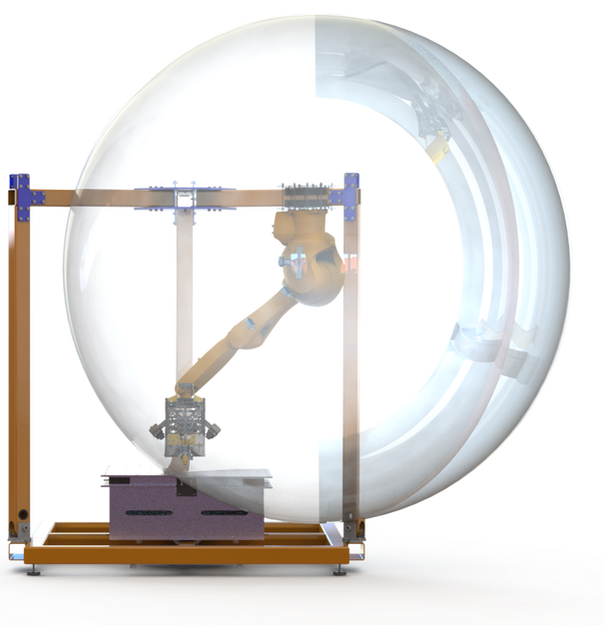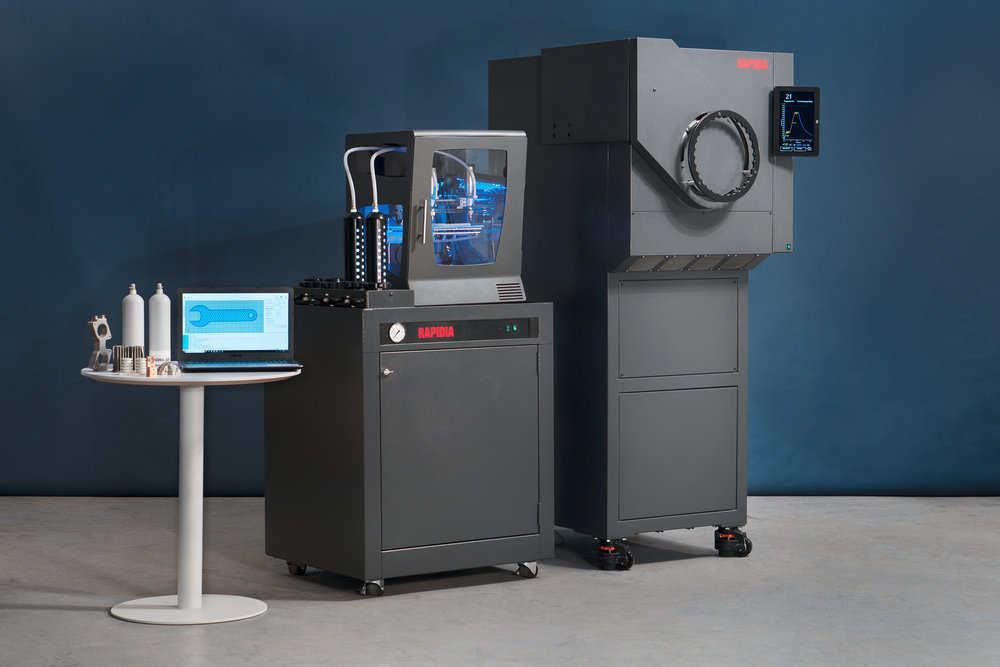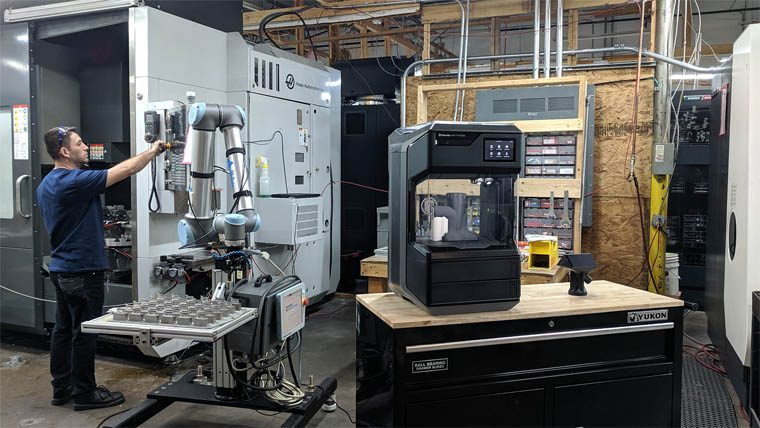This edition of the 3D Printing Industry’s news digest, Sliced, sees a variety of hardware and material releases from Dyze Design, 3D Systems, colorFabb, and EOS, as well as new 3D printing applications in brewing and underwater drones.
All this and more from GE Additive, The Toro Company, Delft University of Technology, Jaguar Land Rover, Additive Manufacturing Technologies, and Singapore University of Technology and Design.
A record-breaking 3D printed fish drone
Sander van den Berg, an Industrial Design Engineering masters student at the Delft University of Technology (TU Delft), Netherlands, has developed a 3D printed robotic fish capable of swimming through water at a record-breaking speed of 0.85 meters per second.
As part of his graduate project, van den Berg, created the fish to be an alternative device to conventional propeller-based underwater drones used to aid divers when identifying hazards. The fish’s body is made from PLA coated with waterproof varnish, a piece of pliable sheet plastic and soft silicone skin. The robotic fish also runs on a single motor.

Elsewhere, in tandem with Oktoberfest 2019, award-winning OEM GE Additive and Kaspar Schulz GmbH, the oldest brewing equipment manufacturer in the world, have developed a metal 3D printed racking blade to improve the sparging process of beer.
3D printing and hardware
In hardware, Airtech Advanced Materials Group, a Californian manufacturer of vacuum bagging and composite tooling materials for autoclave processes, has invested in a Large Scale Additive Manufacturing (LSAM) system from Thermwood Corporation.
The Toro Company, an American manufacturer of turf maintenance equipment, has integrated PostProcess Technologies’ PostProcess BASE support removal solution to eliminate manual post-printing for its 3D printed parts.
In Germany, the Institute of Micro Technology and Medical Device Technology (MIMED) at the Technical University of Munich (TUM) has purchased a PostPro3DMini from Additive Manufacturing Technologies (AMT) an award-winning Sheffield-based OEM.
The Center for Biomolecular Nanotechnologies (CBN) of the Istituto Italiano di Tecnologia (IIT) in Genoa, Italy, is using the DragonFly additive manufacturing system from Nano Dimension to 3D print embedded sensors in electrical packaging. Professor Massimo De Vittorio, CBN-IIT, added:
“The suitability of the DragonFly system to rapidly and affordably manufacture functional prototypes, combined with the broad ecosystem of applications for health and energy harvesting, makes it an ideal choice for our team to achieve higher performance, quick development and print complex shapes not achievable using traditional manufacturing processes.”
Californian Orbital Composites, has introduced “Orb”, a modular, robotic 3D printing system comprising of a high-volume thermoplastic printhead and 1 meter by 1-meter build platform. Based on a custom 6-axis robotic arm from KUKA, the Orb is designed to efficiently scale large parts with complex shapes. Furthermore, the Orb is controlled by proprietary Orb OS software and integrates 5G.
“We seamlessly integrate into a 5G-enabled Industry 4.0 environment, allowing mobile factories of the future to be a reality now,” added Cole Nielsen, Orbital Composites founder and CTO. “Just as software-defined networking revolutionized the modern data center, our novel software approach will revolutionize industrial 3D printing and usher in a new era of software-defined manufacturing.”

Elsewhere, the Sharjah Research Technology and Innovation Park (SRTIP), United Arab Emirates (UAE), has opened the Middle East Additive Manufacturing Centre, which will be fitted with a range of industrial 3D printers from GE Additive.
According to Fahmi Al-Shawwa, CEO of Immensa Technology Labs, a Dubai-based metal 3D printing who has joined the new centre, “We are very pleased to be partnering with SRTI Park in establishing a production facility for the manufacture of metal additives and look forward to working with the team in building the UAE’s position as a global center for industrial 3D printing.”

Canadian 3D printer component manufacturer Dyze Design has announced two new extruders with a maximum temperature of 500°C: the Typhoon filament extruder and the Pulsar pellet extruder.
Also in Canada, 3D printer OEM Rapidia has announced commercial shipments and the first installation of its metal 3D printing system at Hatch Accelerator, a start-up incubator from the University of British Columbia.

Additive manufacturing and healthcare
California-based medical 3D printing service bureau PrinterPrezz has partnered with Osseus Fusion Systems, a Texan medical device company, to develop new spinal interbody fusion devices. The partners aim to submit applications for the next generation of Aries devices to the U.S. Food and Drug Administration (FDA) later this year. This includes ALIF, cervical and expandable lumbar fusion cage designs.
Elsewhere, researchers from the Singapore University of Technology and Design (SUTD) have developed data-driven software which further embraces the complex shapes designed for additive manufacturing. In doing so, a 3D printed ankle brace was created using metamaterials to optimize performance.
According to Dr. Yi Xiong, the first author of this study and research fellow from SUTD, “Previously, it was hard for designers to imagine a design of such complex geometry due to the limitations in conventional manufacturing, but now this design is easily achievable with AM.”
“Our new approach allows designers to embrace the design freedom in AM that comes with the shift in design paradigm and create more optimal products similar to the ankle brace.” The paper ‘Data-Driven Design Space Exploration and Exploitation for Design for Additive Manufacturing‘ was published in the ASME Digital Collection.

A team from Jaguar Land Rover has developed a lightweight, 3D printed glove designed to better protect employees on the production line from the threat of a musculoskeletal disorder.
According to the company, musculoskeletal disorders, which include more than 100 different types of conditions, account for around 30% of all workplace injuries that result in time off and a third of the money paid in compensation to employees. As a result, the team modeled gloves in different densities using TPU, and ULTRASINT, a new, flexible material from BASF for HP’s solution. A second-generation prototype is now being developed to include a foam pad.

Moving more into the automotive sector, POLY-SHAPE, a French metal additive manufacturing service provider, has 3D printed trophies for the Aragon Motorcycle Grand Prix in Spain. Sponsored by Michelin Motorsport, the Aragon Motorcycle Grand Prix, which took place from the 20th-22nd of this month, is said to be a challenging circuit.
The company emulated the twists and turns of the track when designing the 3D printed trophies as well as the Michelin tire design. Piero Taramasso, the Michelin Motorsport Two-Wheel Manager, explained, “Aragon is a very demanding circuit, its layout needs close attention and the surface can be cool in the mornings, very hot in the afternoon and can also be quite abrasive if the wind blows the dust over it from the surrounding area.”

French aeronautical electrical company, and Betatype, UK-based developers of additive manufacturing software, are continuing its partnership to optimize metal 3D printed aerospace parts. As a result, a second-generation auxiliary power unit Generator housing pilot part was produced with a 30% weight reduction. See the full case study here.
Makerbot, All Axis Robotics & Precision ASA
All Axis Robotics, a Texas-based machine shop, has used the METHOD X 3D printer from MakerBot to produce custom tooling parts for its legacy machines as well as its customers. Such machines streamline manufacturing operations with robotic arms and custom end-effectors.
“One of the challenges we faced when adapting our collaborative robots and automation in the machine shop was the need to develop custom parts during the process,” said Gary Kuzmin, CEO of All Axis Robotics.
“We would have to develop custom brackets, fixtures, or fingers for the grippers, and not all of this would be possible to produce on CNC machines. When we purchased the MakerBot METHOD, we automatically obtained all that capability for customizing all these different parts.”
MakerBot has also expanded its materials portfolio with the availability of Precision ASA, a weather-resistant alternative to ABS designed for outdoor applications.

New additive manufacturing materials
Award-winning American 3D printer OEM 3D Systems has unveiled a new material for end-use plastic parts called the Figure 4 Production Black 10 (PRO-BLK 10).
Leading OEM EOS has released EOS TPU 1301, a flexible polymer material for industrial 3D printing. As stated by Tim Rüttermann, Senior Vice President Polymer Systems & Materials at EOS, EOS TPU 1301 exhibits great resilience after deformation, very good shock absorption, and very high process stability.
Finally, colorFabb, a Netherlands-based 3D printing materials company, debuted varioShore TPU, a filament with multiple shore hardnesses depending on the print settings. It is set to be available in mid-October.

For more news subscribe to the 3D Printing Industry newsletter, follow us on Twitter and like us on Facebook. Seeking jobs in engineering? Make your profile on 3D Printing Jobs, or advertise to find experts in your area.
Featured image shows the Sliced logo over a close-up of the 3D printed Michelin trophies. Photo via Michelin Motorsport.


